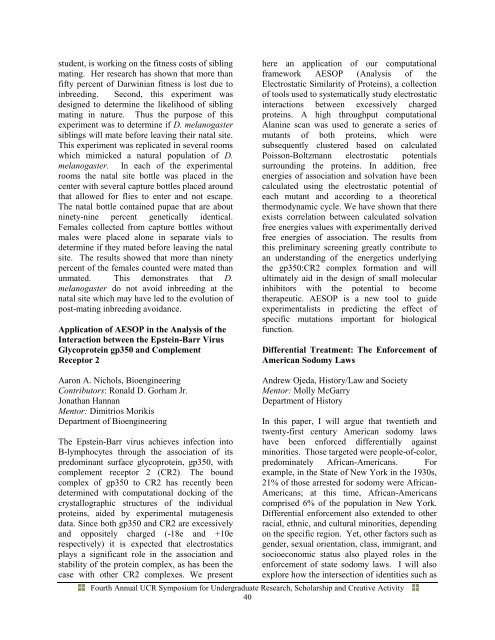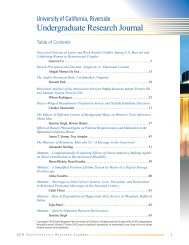2010 - Undergraduate Research, Scholarship and Creative Activity
2010 - Undergraduate Research, Scholarship and Creative Activity
2010 - Undergraduate Research, Scholarship and Creative Activity
You also want an ePaper? Increase the reach of your titles
YUMPU automatically turns print PDFs into web optimized ePapers that Google loves.
student, is working on the fitness costs of sibling<br />
mating. Her research has shown that more than<br />
fifty percent of Darwinian fitness is lost due to<br />
inbreeding. Second, this experiment was<br />
designed to determine the likelihood of sibling<br />
mating in nature. Thus the purpose of this<br />
experiment was to determine if D. melanogaster<br />
siblings will mate before leaving their natal site.<br />
This experiment was replicated in several rooms<br />
which mimicked a natural population of D.<br />
melanogaster. In each of the experimental<br />
rooms the natal site bottle was placed in the<br />
center with several capture bottles placed around<br />
that allowed for flies to enter <strong>and</strong> not escape.<br />
The natal bottle contained pupae that are about<br />
ninety-nine percent genetically identical.<br />
Females collected from capture bottles without<br />
males were placed alone in separate vials to<br />
determine if they mated before leaving the natal<br />
site. The results showed that more than ninety<br />
percent of the females counted were mated than<br />
unmated. This demonstrates that D.<br />
melanogaster do not avoid inbreeding at the<br />
natal site which may have led to the evolution of<br />
post-mating inbreeding avoidance.<br />
Application of AESOP in the Analysis of the<br />
Interaction between the Epstein-Barr Virus<br />
Glycoprotein gp350 <strong>and</strong> Complement<br />
Receptor 2<br />
here an application of our computational<br />
framework AESOP (Analysis of the<br />
Electrostatic Similarity of Proteins), a collection<br />
of tools used to systematically study electrostatic<br />
interactions between excessively charged<br />
proteins. A high throughput computational<br />
Alanine scan was used to generate a series of<br />
mutants of both proteins, which were<br />
subsequently clustered based on calculated<br />
Poisson-Boltzmann electrostatic potentials<br />
surrounding the proteins. In addition, free<br />
energies of association <strong>and</strong> solvation have been<br />
calculated using the electrostatic potential of<br />
each mutant <strong>and</strong> according to a theoretical<br />
thermodynamic cycle. We have shown that there<br />
exists correlation between calculated solvation<br />
free energies values with experimentally derived<br />
free energies of association. The results from<br />
this preliminary screening greatly contribute to<br />
an underst<strong>and</strong>ing of the energetics underlying<br />
the gp350:CR2 complex formation <strong>and</strong> will<br />
ultimately aid in the design of small molecular<br />
inhibitors with the potential to become<br />
therapeutic. AESOP is a new tool to guide<br />
experimentalists in predicting the effect of<br />
specific mutations important for biological<br />
function.<br />
Differential Treatment: The Enforcement of<br />
American Sodomy Laws<br />
Aaron A. Nichols, Bioengineering<br />
Contributors: Ronald D. Gorham Jr.<br />
Jonathan Hannan<br />
Mentor: Dimitrios Morikis<br />
Department of Bioengineering<br />
The Epstein-Barr virus achieves infection into<br />
B-lymphocytes through the association of its<br />
predominant surface glycoprotein, gp350, with<br />
complement receptor 2 (CR2). The bound<br />
complex of gp350 to CR2 has recently been<br />
determined with computational docking of the<br />
crystallographic structures of the individual<br />
proteins, aided by experimental mutagenesis<br />
data. Since both gp350 <strong>and</strong> CR2 are excessively<br />
<strong>and</strong> oppositely charged (-18e <strong>and</strong> +10e<br />
respectively) it is expected that electrostatics<br />
plays a significant role in the association <strong>and</strong><br />
stability of the protein complex, as has been the<br />
case with other CR2 complexes. We present<br />
Andrew Ojeda, History/Law <strong>and</strong> Society<br />
Mentor: Molly McGarry<br />
Department of History<br />
In this paper, I will argue that twentieth <strong>and</strong><br />
twenty-first century American sodomy laws<br />
have been enforced differentially against<br />
minorities. Those targeted were people-of-color,<br />
predominately African-Americans. For<br />
example, in the State of New York in the 1930s,<br />
21% of those arrested for sodomy were African-<br />
Americans; at this time, African-Americans<br />
comprised 6% of the population in New York.<br />
Differential enforcement also extended to other<br />
racial, ethnic, <strong>and</strong> cultural minorities, depending<br />
on the specific region. Yet, other factors such as<br />
gender, sexual orientation, class, immigrant, <strong>and</strong><br />
socioeconomic status also played roles in the<br />
enforcement of state sodomy laws. I will also<br />
explore how the intersection of identities such as<br />
Fourth Annual UCR Symposium for <strong>Undergraduate</strong> <strong>Research</strong>, <strong>Scholarship</strong> <strong>and</strong> <strong>Creative</strong> <strong>Activity</strong><br />
40














